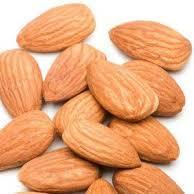An energy-restricted, almond-enriched diet (AED) is as effective as an energy-restricted nut-free control diet (NFD) in promoting and maintaining weight loss, reports a study, noting that both diets support cardiometabolic health.
In addition, the AED also provides benefits on some lipoprotein subfractions, resulting in greater reductions in cardiovascular risk.
“Replacing typical snacks with almonds can have a meaningful impact on lipoprotein subfractions, shifting to a less atherogenic pattern, and as such, health professionals can recommend almonds as part of a balanced weight loss diet,” the investigators said.
In this study, weight and cardiometabolic outcomes were assessed after a 3-month energy restricted diet (‒30 percent) containing almonds or carbohydrate-rich snacks (phase 1), followed by 6 months of weight maintenance (phase 2). Participants aged 25‒65 years with overweight or obesity were randomized to either AED (n=68) or NFD (n=72).
Participants in both groups achieved weight loss during phase 1 (AED vs NFD: mean, ‒7.0 vs ‒7.0 kg; p=0.858) and phase 2 (mean, ‒1.1 vs ‒1.3 kg; p=0.756), with improvements in percentage lean mass after phase 2 (4.8 percent; p<0.001). [Obesity 2023;31:2467-2481]
Both groups also had reductions in fasting glucose (‒0.2 mmol/L; p=0.003), insulin (‒8.1 pmol/L; p=0.036), blood pressure (BP; ‒4.9 mm Hg systolic, ‒5.0 mm Hg diastolic; p<0.001), total cholesterol (‒0.3 mmil/L), low-density lipoprotein (LDL; ‒0.2 mmol/L), very low-density lipoprotein (‒0.1 mmol/L), and triglycerides (‒0.3 mmol/L; p<0.001 for all), and an increase in high-density lipoprotein (HDL; 0.1 mmol/L; p=0.011) by the end of phase 2.
Moreover, group by time interactions were seen for lipoprotein particle concentrations: very small triglyceride-rich (AED vs NFD: ‒31 vs ‒4.8 nmol/L; p=0.007), small LDL (‒109.3 vs ‒20.7 nmol/L; p=0.017), and medium LDL (‒24.4 vs ‒130.5 nmol/L; p=0.045).
Cardiometabolic health
“This clinically significant weight loss is likely responsible for the improvements in cardiometabolic risk factors seen in both groups,” the investigators said. [Postgrad Med 2022;134:359-375]
Previous studies showed that moderate weight loss (5 percent to 10 percent) resulted in decreases in BP and triglycerides, improved glycaemic control, and increased HDL, while a 5-mm Hg reduction in systolic BP lowered the risk of major cardiovascular events by 1 percent. The current study reported a 4.9 mm Hg decrease in both groups. [Curr Obes Rep 2017;6:187-194; Lancet 2021;397:1625-1636]
A few trials that explored the effects of nuts within weight loss interventions had mixed results. These studies also had considerable differences in duration (3, 6, or 18 months), incorporated different amounts of nuts (50‒84 g), and implemented different energy restriction targets (500, 1,000, or 1,200‒1,800 kcal/d). [J Nutr 2016;146:2513-2519; Am J Clin Nutr 2012;96:249-254]
Notably, trials that had longer duration and implemented a greater degree of restriction achieved greater weight loss, as well as better outcomes for the nut-enriched diets seen in two studies. [J Res Med Sci 2014;19:457-464; Int J Obes Relat Metab Disord 2003;27:1365-1372]
“Future studies should consider the dose of almonds and testing in populations with elevated cardiometabolic risk factors, such as populations with metabolic syndrome,” the investigators said.
“The satiating effects of almonds need further investigation as almonds may assist with hunger management, and this may explain why some intervention studies have seen differences in weight loss between groups,” they added.

